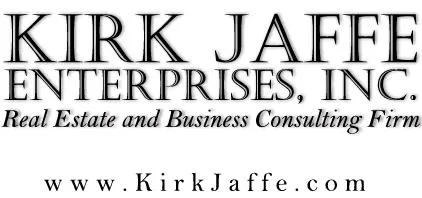Unlock Your Business's Profit Potential with the Momentum-Maker Mastermind
If you are a small business owner who wants to take your business to the next level, increase your impact, and income… Join our Next "Momentum-Maker" LIVE Session FREE
The Next Live Session is on: April 12th @9:45 AM (Pacific Time)

Our Services
Kirk Jaffe Enterprises, Inc. has multiple services for home buyers and business owners.
Make us your preferred solution for home and commercial real estate.

MORTGAGE LENDING
We offer the most competitive rates and excellent service beyond closing. Guaranteed! PRO.
REAL ESTATE AND PROFESSIONAL CONSULTING
We offer guidance to real estate professionals, tax professionals, lawyers, and CPA's.
BUSINESS CONSULTING
Are you ready to grow your business to
the next level and beyond. Kirk has helped hundreds of businesses and
can help you get there faster.
INVESTMENT ASSISTANCE
Our proven track record in solid investments has help hundreds and could help you too. Ask us how!

FIND OUT WHY KIRK JAFFE IS THE BEST CHOICE FOR LOANS AND HELPING BUSINESSES GROW!
Kirk Jaffe, CEO/Founder – Executive Management of $200MM private investment fund including Mortgage Notes, Real Estate Owned (REO) and Commercial Property Holdings. He has overseen and held executive authority of over 20,000 real estate transactions in his 20-year real estate career including buying and selling of property, foreclosure, short sale, loan modification, rehabilitation of property with an aggregate over $1 Billion value. Kirk has also originated over $ 1 Billion of new Mortgages.
Kirk is the past President of the Universal City/North Hollywood Chamber of Commerce as well as a former co-chair of the ALFN Commercial Practices Committee. He is active as a speaker and moderator of several trade organizations including the CA Mortgage Bankers Association (CMBA), Mortgage Banking Association (MBA), and the Attorney Legal Financial Network (ALFN). Mr. Jaffe is quoted or has been a guest of several media outlets including: KABC790 Talk Radio, NBC and the Los Angeles Daily News to name a few.
Kirk Has Appeared On:
How Can We Help
You Today?


Start Quote

Change Plan

Contact
Let Us Know What You Need!
We custom fit every service to your personal business needs. Whatever it is, we have a solution. Just click the button below to get assistance today!
If you're looking for a firm who can help you with not just your mortgage, but help you GROW YOUR BUSINESS FAST... you're where you should be!
MORTGAGE LENDING
We offer Custom Tailored mortgages for Home or Business!
BUSINESS CONSULTING
Grow your business FAST with our Business Consulting Services!
INVESTMENT CONSULTING - REAL ESTATE ASSETS
Our win/win approach to investing has helped hundreds. FIND OUT MORE!
REAL ESTATE PROFESSIONALS
If you are a real estate professional and are ready to work with a partner with years of experience, you're in the right place.
CPAS, ATTORNEYS, AND INSURANCE PROFESSIONALS
If you have questions about the potential legal implications of real estate transactions for your clients, Kirk Jaffe has the answers!
GET STARTED TODAY
Getting started with Kirk Jaffe Enterprises is super easy. Find out how it works below!
WHAT OUR CLIENTS HAVE TO SAY

“What a GREAT guy Kirk is! I highly recommend him and his services all the time and for my own home loan needs. Why would I say that as a Broker myself? Well as a Buyer and a Broker I cannot have my hand into many aspects of the transaction, so I trust Kirk with my financing needs he has yet to let me down! "
Steve Duncan

"Kirk is my go-to lender. He has worked many “miracle situations” and provides top notch service from start to finish...."
Jeff J. Grice

"I have known Kirk Jaffe for many years. Kirk has a stellar reputation. You can see his reviews by going to www.mycity.com/profile/kirk-jaffe."
Bob Friedenthal

"When I need any information regarding the Real Estate Financing space for a client, my first call is to Kirk Jaffe. He is knowledgeable, professional, and experienced. He stays on top of cases and follows up with clients. He is a true asset to my business."
Bruce Fine

"Kirk works hard and well day and night, a kind person and gets it done fast!"
Melissa Oppenheimer

"Kirk did a fabulous job. He walked me thru the process and it was incredibly easy compared to other mortgages I've done. Thanks to Kirk, my house closed in under 21 days, and he got me a great interest rate."
CHARLIE JEWETT

WHY WORK WITH KIRK JAFFE ENTERPRISES, INC?
Because we offer the best service at affordable rates and will help your company grow faster! Click the button or
CALL US AT (775) 415 - KIRK (5475)

Renowned housing analyst who predicted the 2008 home price crash weighs in on the current market
To better understand Bill McBride's perspective on the current housing and economic cycle, ResiClub reached out and conducted a Q&A with him.
Years before the housing bubble burst in 2008, housing analyst Bill McBride began chronicling the troubles in the U.S. housing market in his blog Calculated Risk.
Not only did he predict the crash, but he also called the 2012 housing price bottom. Fast-forward to 2024, and this cycle he hasn’t been as concerned as he was in 2007.
McBride has maintained for the past few years that this housing cycle will ultimately resemble something closer to the 1978 to 1982 period—a time of overheated house price growth that saw spiked interest rates, strained affordability, crashed existing home sales volume, and yet no national home price crash—rather than the 2007-2011 national housing price crash years.
To better understand Bill McBride's perspective on the current housing and economic cycle, ResiClub reached out and conducted a Q&A with him.
Q: Historically speaking, the economy usually sees a rollover in residential construction employment prior to the onset of the recession. So far, residential construction employment has stayed near cycle highs. Is that a signal for a soft landing? Or could the rollover simply be delayed by the huge pipeline of multifamily units?
New home sales and housing starts are excellent leading indicators for the economy. However, with existing home sales depressed due to a combination of limited existing home inventory and stretched affordability, new home sales and single-family housing starts have performed fairly well. This is because the homebuilders have been able to offer incentives, such has buying down mortgage rates, to boost sales. The current residential construction weakness – as you noted – is in the multi-family sector, and this isn’t as reliable a leading indicator for the economy as the single-family sector. It seems likely we will see construction employment decline later this year or in 2025 as multi-family units are completed. And there is also weakness in some commercial real estate sectors, especially the office and retail sectors. However, these sectors do not employ as many workers as the single-family residential sector, and it seems unlikely this will lead to a recession in the near term.

Q: While national active inventory for sale is rising on a year-over-year basis, national home prices continue to inch higher. Is there a certain level of inventory or months of supply in which you think we’d start to see national home prices fall again or soften?
The rule of thumb has been that house prices decline with more than 6 months of inventory. However, in 2022, we saw national price declines (as measured by Case-Shiller) with months-of-supply in the 3s! This was probably because inventory increased sharply in 2022, and some potential sellers were remembering what happened during the housing bust with cascading price declines. Months-of-supply as reported by the National Association of Realtors (NAR) has been rising steadily, and the NAR reported months-of-supply was 3.7 in May [the chart below shows 3.6 because it’s using a different series]. I expect this measure to continue to increase, and be over 4 months soon – and to be above 2019 levels in a few months. This doesn’t mean national price declines, but it suggests price growth will slow significantly later this year. We might see national price decline with months-of-supply above 5 (as opposed to 6) since most potential sellers have substantial equity and might be willing to sell for a little less. I’m tracking this very closely, for example see: Watch Months-of-Supply!

Q: What is causing the sharp increase in inventory in the South, especially in Florida and Texas?
Inventory is up sharply, and already above 2019 levels in many parts of Florida. I think the primary reason is the lack of affordable homeowners’ insurance because of destructive storms and rising sea levels due to climate change. A year ago I wrote: The Long-Term Housing and Population Shift. I noted that a combination of water availability and widespread use of AC drove the growth in the West and South over the last 60 years. However, climate change might make some areas further north more desirable. I think we are starting to see the start of that trend!

Q: You rightly called the housing crash before it started in 2006. When did you start to realize something bad was brewing?
In 2004, I was talking with a young woman at my gym, and she told me she just bought a $400K condo with no money down. I knew how much she made, about $40K per year, and the numbers seemed crazy. She told me she had a 1% teaser rate for the first two years. What happens after that I asked? She said she’d either refinance or sell the condo for a profit. That conversation started me on a journey of discovery. I started the Calculated Risk blog in January 2005 to share my thoughts with a few friends and colleagues. The key question was: Why are lenders making loans that would likely default? My friend and mortgage expert, Doris “Tanta” Dungey (see Doris Dungey, Prescient Finance Blogger, Dies at 47) joined the blog helped answer that question. And I was able to predict that house prices would fall sharply in many areas, exacerbated by a flood of distressed sales, and that this would lead to a recession – and possibly a financial crisis. In 2005, I argued inventory would tell the tale, and when inventory started increasing sharply in the 2nd half of 2005, I called the top for house prices. I’m still watching inventory closely (although there will be few distressed sales this time). Some people thought I was crazy when I argued house prices would fall 40%+ in some areas, but that is what happened. I also called the bottom for the economy in early 2009 (Looking for the Sun), and for house prices in 2012 (The Bottom is Here). Many of my readers thought I was a permabear, and were surprised when I turned optimistic!

Q: What do you think is the biggest long-term headwind facing the U.S. housing market? And what do you think is the biggest long-term tailwind facing the U.S. housing market?
Probably the biggest headwind is restrictive policies that limit construction in many desirable areas. For California, this is a severe problem. Other headwinds include the lack of water in the Southwest, and the impact of climate change, especially in some of the southern states. Perhaps the biggest tailwind, at least compared to other first world countries, is favorable demographics. Also, as climate change slows growth in certain states, it will likely be a positive for states with plenty of water and buildable land.
©Resi Club Analytics

CONTACT US TODAY
Need to reach us? Send us an email or give us a call today.
Kirk Jaffe Enterprises, Inc.
195 Highway 50, Ste 104-476
Stateline, NV 89449










